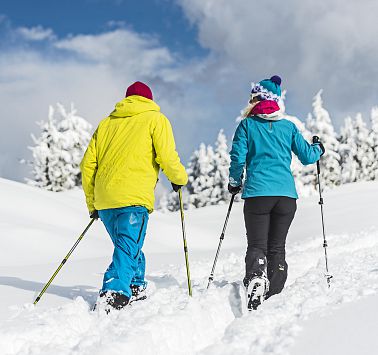Tirolean mountain guides

Winter hiking is great for your health and provides a sense of community. Nevertheless, safety is paramount to your winter hiking experience. It is therefore important that you observe and comply with essential rules of conduct and instructions. Accurate tour planning and adequate equipment are also essential ingredients for a successful winter hike.
The Austrian Alpine Club provides ten recommendations designed to make your winter hike as safe and enjoyable as possible.
Hiking in winter is an endurance sport. You must make a realistic self-assessment and be in good health to be able to cope with the positive effects of exercise on the heart and circulation. Avoid time pressures and set the pace so that nobody in the group gets out of breath.
Hiking maps, guidebooks, the internet and local experts can provide information about the length, difference in altitude, difficulty and the prevailing conditions. Always tailor your tours to the fitness of the group and pay particular attention to the weather and avalanche forecast. Precipitation, wind and cold increase the risk of accidents.
Potential hazards include
: sudden falls in temperature, snowfall, wind, avalanches, fog, ice, sun (diurnal heating – increased risk of avalanches)
Various weather conditions change the terrain every day. You are personally responsible for assessing at your own discretion whether a route is safe!
Current Avalanche Report Tirol
Here you will find all the information on regional avalanche danger levels, snowpack structure, danger patterns, trends, alpine weather report and much more.
Or you can get real-time information on the current avalanche situation via the "Avalanche Tyrol" app.
Download for iOS devices
Download for Android devices
Pack appropriately for your chosen tour and make sure your backpack is light. Always pack appropriate protection from the rain, cold and sun as well as a first aid kit and mobile phone (Euro-emergency call 112). For better orientation, consider using a map, apps or GPS.
Sturdy mountaineering boots protect and relieve pressure on the foot, improving surefootedness. Ensure yours are a perfect fit, have an anti-slip tread and are waterproof and lightweight.
Falls, as a result of slips or stumbles, are the most common cause of accidents. Be aware that tiredness and going too fast can have a serious effect on your surefootedness and concentration. Take special care when descending!
In pathless terrain, the risk of losing your bearings and falling increases. Avoid shortcuts. If you have strayed from the route, return to the last known point.
Timely rests ensure that you can recover, enjoy the scenery and the company. Food and drink are essential for sustaining performance and concentration. Isotonic drinks are ideal thirst quenchers.
Note that children love variety and playful discovery! In passages where there’s a risk of falling, an adult can look after only one child. Very exposed tours that require sustained concentration are not suitable for children.
Small groups ensure flexibility and promote mutual assistance. Inform trusted people about your destination, route and return time. Stay together as a group. Solo hikers beware: Even minor incidents can become serious emergencies.
To protect the mountain environment: do not leave any rubbish behind, avoid making a noise, stay on the paths, do not worry wildlife or grazing animals, leave plants untouched and respect conservation areas. Use public transport or carpool whenever possible.
Respect protected areas and sanctuaries harbouring plants and animals!!
- Avoid dusk and dawn (feeding and grazing times) - Plan your tour between 10 am and 4 pm
- Avoid game feeding and wildlife territories (stay at least 300 m away and pay attention to restricted areas!)
- Observe animals only from a great distance and do not pursue them under any circumstances
- Do not enter areas of afforestation or young trees.
- Keep quiet and do not shout.
Dogs
Please use dog waste bags and dispose of them in the nearest bin to avoid contaminating the pastures and natural environment. Help to keep the hiking trails clean. To avoid problems with cross-country skiers, snowshoe hikers and other winter sportspeople, always keep your dog(s) on a lead.
Rubbish
Nature is precious – so please keep the mountains clean and take your rubbish with you. Your rubbish will stay here, even when you’re long gone!
Was ist im Notfall zu tun?
Notruf wählen
140 - Alpinnotruf (Bergrettung)
112 - Europäischer Notruf
133 - Polizei
144 - Rettung
Winter hiking routes in the Wilder Kaiser region are either marked with a dark green arrowhead and a white snow star on the yellow hiking trail signs or there are also green signs along the cross-country ski trails.
The information on the yellow hiking trail signs from summer is for orientation purposes only and is not valid in winter (especially pictograms/huts, hiking times and trail numbers).
Be careful when leaving the marked winter hiking routes. In snowy conditions, the summer hiking trail network and its markers are not visible, putting you at risk of disorientation and Alpine hazards.
There is no connection between the trail numbers on the yellow hiking trail signs (summer) and the tour numbers on the winter map.
Calculating hiking times:
The rule of thumb for calculating the hiking time for a medium-sized group of 4 to 6 people is as follows:
approx. 300 m elevation per hour in ascent and
approx. 500 m elevation in descent
approx. 3 km
The hiking times for the differences in altitude and for the horizontal length are calculated separately.
Please note that the information provided regarding safety in the mountains is a recommendation only on behalf of the Tourismusverband Wilder Kaiser. All information is subject to change without notice.